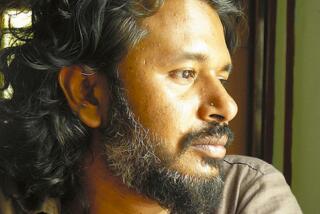R.K. Narayan; Wry Novelist Brought India to the World
- Share via
Rasipuram Krishnaswami Narayan, India’s much-loved storyteller whose spare, wry English-language novels and short stories gave the world insight into the richness and depth of life and literature in India, died Sunday in his native Madras. He was 94.
Narayan, whose 34 books of elegantly subtle, simple and universal fiction made him India’s most notable writer in English, died in his sleep of heart failure. He had been hospitalized last month with internal bleeding prompted by a duodenal ulcer.
“In Narayan’s passing away, India has lost one of its finest authors, and one whose books I have enjoyed reading for many years,” India’s Prime Minister Atal Behari Vajpayee said Sunday.
The author’s prolific works were translated into all European languages, Hebrew, and India’s own Hindi and other tongues. Narayan also expanded the English lexicon with such India-based words as “swat,” meaning ridding oneself of flies.
Narayan, who shortened his pen name to R.K. Narayan after British novelist Graham Greene, who became his mentor and friend for more than 50 years, advised him in 1935: “In this country, a name which is difficult for the old ladies in libraries to remember materially affects sales.”
Absent the encouragement of Greene, who died in 1991 at age 86, Narayan might never have achieved worldwide notice. Greene once referred to Narayan as “the novelist I most admire in the English language.” He wrote in a forward to Narayan’s 1990 book, “The World of Nagaraj”: “Narayan wakes in me a spring of gratitude, for . . . without him I could never have known what it is like to be Indian.”
Narayan’s writing, set in India but universal in theme, came to be compared to that of Greene. Scholars later saw in a collection of letters between the two men (they met only once, in London in 1964)--auctioned in 1996--that Narayan influenced Greene’s work as well.
A schoolmaster’s son, Narayan grew up in Madras and Mysore in southern India, earned a degree at what is now the University of Mysore and taught--but fervently longed to write. He took a job as a journalist covering the Mysore police beat while penning copious fictional stories about everyday life.
Discouraged when his first manuscript failed to sell, he shipped it to a friend studying at Oxford with the rueful advice to “weight it with a stone and drown it in the Thames.” Instead, the friend put it before Greene, who pronounced it “excellent,” gently offered to correct lapses in Narayan’s English and got the book published.
The result was “Swami and Friends,” published in 1935, Narayan’s first novel, based largely on his experiences as a schoolteacher.
However imperfectly, Narayan once said he wrote easily in English, considering it “a very adaptable language . . . so transparent it can take on the tint of any country.”
Narayan’s simple titles often succinctly described his subject--”The Bachelor of Arts,” “The English Teacher,” “The Financial Expert” and “The Guide,” which was made into an Indian motion picture and in 1968 an off-Broadway play.
About half of Narayan’s works were set in the fictional Mysore-like village of Malgudi, which became as familiar to many readers as William Faulkner’s Southern town of Jefferson in Yoknapatawpha County, based on Faulkner’s native Jefferson, Miss.
“Only by memorizing the Bhagavad-Gita, joining an ashram or learning to sleep on a bed of nails could you experience India more intensely than by reading Narayan,” observed Elaine Kendall, in reviewing Narayan’s “Malgudi Days” for The Times in 1982. “Malgudi is more than an extended metaphor for India; it has become an embassy to the world outside, representing that paradoxical country to the fascinated and puzzled West.”
In reviewing Narayan’s last book, “A Grandmother’s Tale and Other Stories,” for The Times in 1994, Judith Freeman wrote: “It is precisely the combination of the comic and tragic that makes Narayan’s stories worthy of the label ‘universal.’ That, and the very ordinariness of the lives he so lovingly renders in fiction. He takes a Western reader into the very heart of an Indian village and the family compounds where the little dramas of marriage and money and kinship inevitably result in a tangle of human ties.”
Not surprisingly, Narayan’s writing was often compared to that of Faulkner as both examined turmoil between characters’ individuality and demands of tradition.
Praised for his subtle simplicity that said much though seeming to say little, Narayan wrote delightfully in the 1983 “A Tiger for Malgudi” about tiger-protagonist Raja’s imprisonment in a circus after the murder of his lioness and pride.
Told in the tiger’s voice, the narrative describes the denouement when “Captain,” the lion tamer captor, exchanges his whip and chair for an electric cattle-prod to make Raja impress a filmmaker: “Forgetting himself enough to approach me beyond the margin of safety which he always maintained for an emergency retreat, he dashed forward with that vicious metal tongue shooting out of its sheath. As he stooped down to caress me with its tip, I just raised a forepaw, taking care to retract my claws, and knocked the thing out of his hand. The blow caught Captain under his chin, and tore off his head.”
Former Times book editor Jack Miles, in reviewing “Tiger,” noted: “In other hands than Narayan’s, a scene like this one would be made an epiphany of violence. The hands are Narayan’s, however, and comic decorum--droll but somehow indestructible--softens every edge.”
Widowed in 1939, Narayan is survived by his cartoonist brother, R.K. Laxman, and two grandsons.
More to Read
Sign up for our Book Club newsletter
Get the latest news, events and more from the Los Angeles Times Book Club, and help us get L.A. reading and talking.
You may occasionally receive promotional content from the Los Angeles Times.









